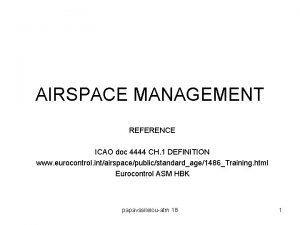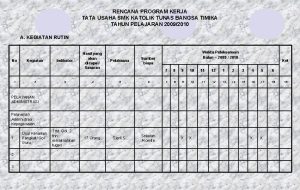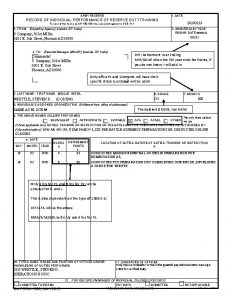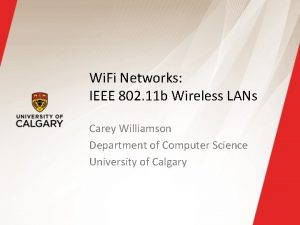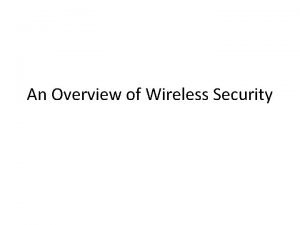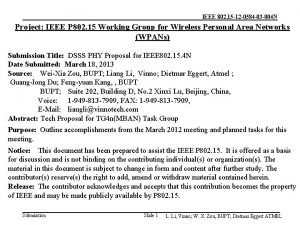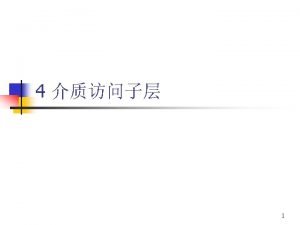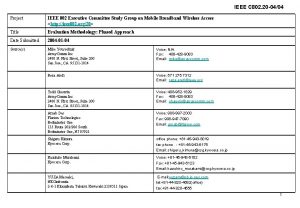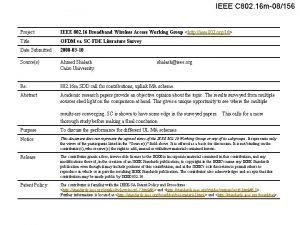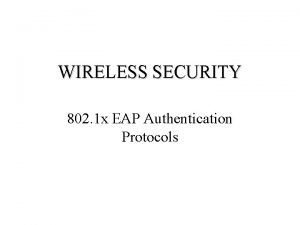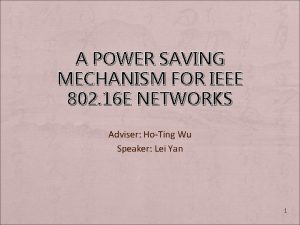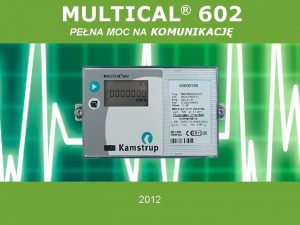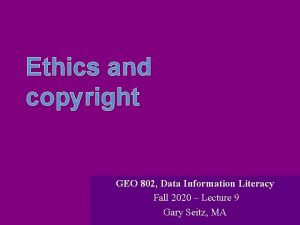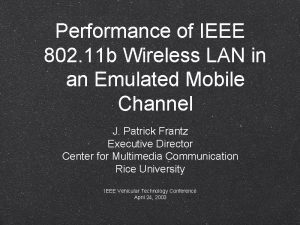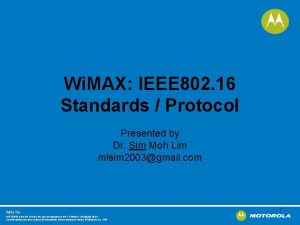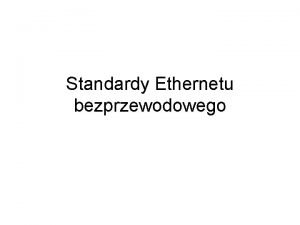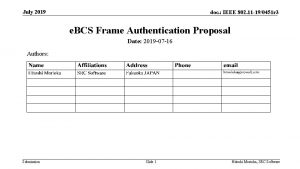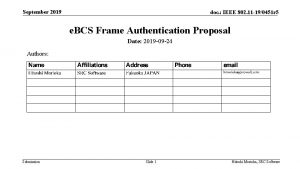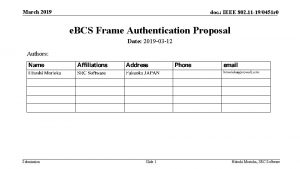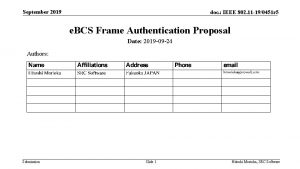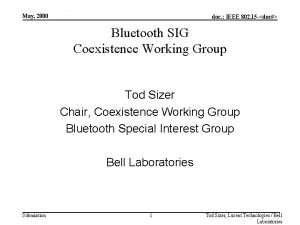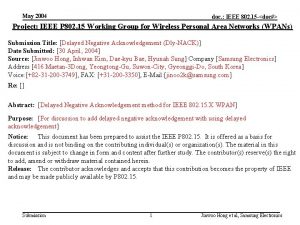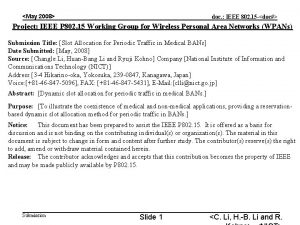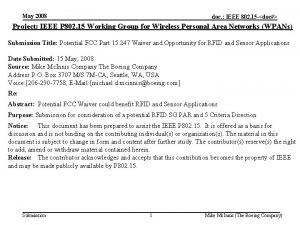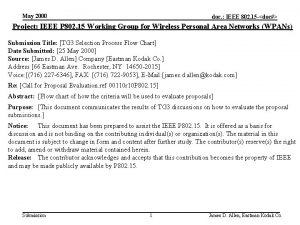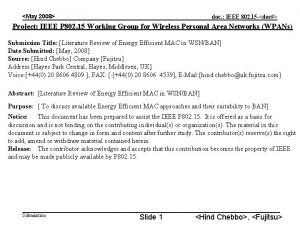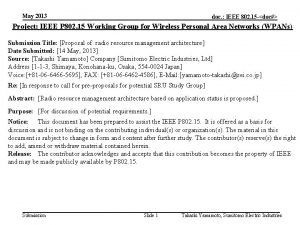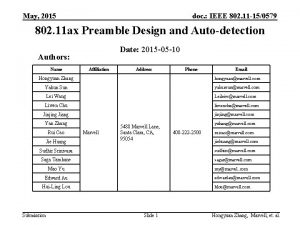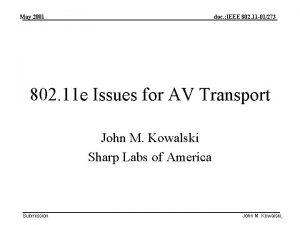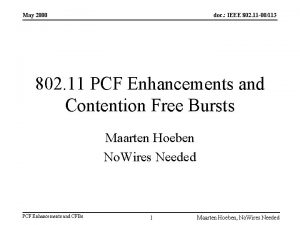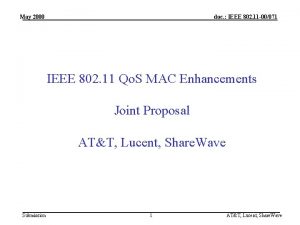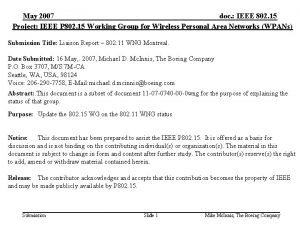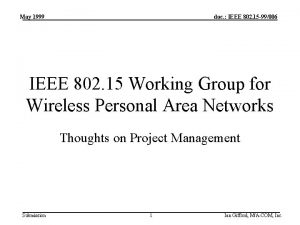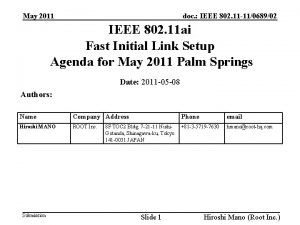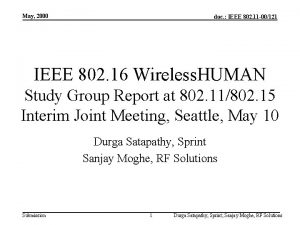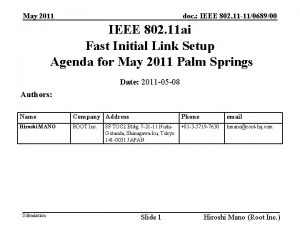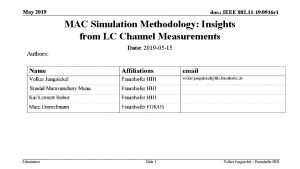May 2019 doc IEEE 802 11 190451 r




























- Slides: 28

May 2019 doc. : IEEE 802. 11 -19/0451 r 1 e. BCS Frame Authentication Proposal Date: 2019 -05 -13 Authors: Submission Slide 1 Hitoshi Morioka, SRC Software

May 2019 doc. : IEEE 802. 11 -19/0451 r 1 Abstract This presentation describes a proposal for e. BCS frame authentication that addresses TGbc R 3 in 11 -19 -151 r 1. Submission Slide 2 Hitoshi Morioka, SRC Software

May 2019 doc. : IEEE 802. 11 -19/0451 r 1 TGbc R 3 • The 802. 11 bc amendment shall provide origin authenticity protection for broadcast data frames. Submission Slide 3 Hitoshi Morioka, SRC Software

May 2019 doc. : IEEE 802. 11 -19/0451 r 1 Architecture Assumption Multicast/Broadcast Frames e. BCS Frames AP STA STA STA • AP broadcasts the e. BCS frames that include the received multicast/broadcast frames. Submission Slide 4 Hitoshi Morioka, SRC Software

May 2019 doc. : IEEE 802. 11 -19/0451 r 1 Problem in Current GTKSA STA STA STA AP Rogue AP • Current GTKSA uses symmetric algorithm. • Both AP and STAs use the same key. • If a user who has malicious intention can join the GTKSA, the user can easily make a rogue AP. • Current GTKSA is not suitable for public use, untrusted user may join. Submission Slide 5 Hitoshi Morioka, SRC Software

May 2019 doc. : IEEE 802. 11 -19/0451 r 1 Requirements for the algorithm STA STA STA AP Rogue AP • Only the correct AP can sign the frames. • STAs can verify the signature. Submission Slide 6 Hitoshi Morioka, SRC Software

May 2019 doc. : IEEE 802. 11 -19/0451 r 1 Digital Signature (Public Key Algorithm) AP STA STA STA Data Private Key Sign Data Public Key Sign • • • Verify AP has a “private key” and “public key” pair. The “private key” is never disclosed. The AP distributes “public key” to STAs. Signature signed by the “private key” can be verified only by the “public key” Remaining issue: How to verify that the “public key” is correct? Submission Slide 7 Hitoshi Morioka, SRC Software

May 2019 doc. : IEEE 802. 11 -19/0451 r 1 Public Key Infrastructure CA AP Sign STA STA STA Data Sign Data Verify Sign • • • Verify Trusted way CA(Certification Authority) has a “private key” and “public key” pair. The CA’s public key is pre-installed in STAs. (e. g. included in application software) The AP’s public key is signed by the CA’s private key. The AP distributes its public key with signature to STAs verify the signature of the AP’s public key by the CA’s public key. Submission Slide 8 Hitoshi Morioka, SRC Software

May 2019 doc. : IEEE 802. 11 -19/0451 r 1 Performance of Digital Signature Intel Core i 7 3. 1 GHz Linux Sign Verify Intel Core i 5 3. 2 GHz Mac. OS Sign Verify AMD Turion II 2. 2 GHz Free. BSD Sign Verify ARM Cortex-A 7 1. 1 GHz Android Sign Verify RSA 2048 2, 651 77 2, 502 72 6, 580 188 94, 073 2, 460 RSA 4096 14, 514 214 13, 267 201 40, 000 643 627, 607 7, 553 DSA L 1024 N 160 225 426 206 390 599 1, 098 7, 274 13, 942 DSA L 2048 N 224 874 1, 694 809 1, 584 2, 360 4, 874 34, 655 68, 362 DSA L 2048 N 256 873 1, 695 799 1, 548 2, 436 4, 702 39, 672 77, 262 DSA L 3072 N 256 1746 3, 496 1, 605 3, 173 4, 896 9, 674 84, 727 169, 804 ECDSA P 256 37 91 33 87 138 247 5, 027 14, 792 ECDSA P 384 4, 459 8, 588 4, 324 8, 560 17, 160 35, 719 94, 448 184, 409 ECDSA P 521 8, 321 16, 538 8, 147 16, 479 35, 759 49, 511 190, 014 360, 304 • • • usec / 1, 500 byte message Digital signature needs high computational cost. It takes more than 2 msec to verify each frame on low-end devices. Other low-weight algorithm should be combined with digital signature. Submission Slide 9 Hitoshi Morioka, SRC Software

May 2019 doc. : IEEE 802. 11 -19/0451 r 1 Timed Efficient Stream Loss-Tolerant Authentication (TESLA) • TESLA is a kind of one-way key chain algorithm published as IETF RFC 4082. • It allows to check the integrity and authenticate the source of each packet in multicast or broadcast data streams by low-cost operations. Submission Slide 10 Hitoshi Morioka, SRC Software

May 2019 doc. : IEEE 802. 11 -19/0451 r 1 Assumption for TESLA • Loose time synchronization between the sender (AP) and receivers (STAs) Submission Slide 11 Hitoshi Morioka, SRC Software

May 2019 doc. : IEEE 802. 11 -19/0451 r 1 Generate One-way Key Chain • Sender(AP) generates 2*N keys. Random Seed K 0 Hash’ K’ 0 Submission K 1 Hash’ K’ 1 K 2 Hash’ Hash KN-1 Hash’ K’ 2 K’N-1 Slide 12 KN Hash’ K’N Hitoshi Morioka, SRC Software

May 2019 doc. : IEEE 802. 11 -19/0451 r 1 Authenticator • Sender add an authenticator to each frame by using key K’n • Key for authenticator is changed in TK • Kn is disclosed at TD = d * TK delay (d >= 2) Key for authenticator K’N-1 K’N-3 K’N-2 K’N-4 K’N-5 time Disclosed Key KN TK KN-1 KN-2 KN-3 TD Submission Slide 13 Hitoshi Morioka, SRC Software

May 2019 doc. : IEEE 802. 11 -19/0451 r 1 Authentication • Receiver buffers frames until the key is disclosed. • The buffered frames are authenticated by the disclosed key. • The key integrity is verified as following: • If Kn = Hash(Kn-1) and Kn is already verified, Kn-1 is correct. Key for authenticator Disclosed Key K’N-1 K’N-5 time KN Hash’ K’N Submission K’N-4 K’N-3 K’N-2 KN-1 Verify Authenticate frames signed by K’N Slide 14 KN-3 KN-2 Verify Hitoshi Morioka, SRC Software

May 2019 doc. : IEEE 802. 11 -19/0451 r 1 Problem on TESLA • KN has to be verified by other method. Submission Slide 15 Hitoshi Morioka, SRC Software

May 2019 doc. : IEEE 802. 11 -19/0451 r 1 Combination of Digital Signature and TESLA • Digital signature is used to authenticate • KN • Timestamp • TESLA is used to authenticate Data frames Submission Slide 16 Hitoshi Morioka, SRC Software

May 2019 doc. : IEEE 802. 11 -19/0451 r 1 Frame Sequence Sender generates one-way key chain before generating each e. BCS Info frame (Kc, N, Kc, N-1, Kc, N-2, …, Kc, 0) e. BCS Info frame Transmitted in TI interval e. BCS Info frame includes • • • Kc, N (where c is the seq num of e. BCS Info) Kc-1, L (where L is the last used key index) Kc-1, L+1 (if d = 2) Timestamp TI TK d e. BCS Info sequence number Public key with CA signature Signature by the sender’s private key e. BCS Data frame includes • • Kc, n+2 (where c is the seq num of e. BCS Info, d=2) Ac, n (Authenticator generated by the key K’c, n) Key index: n e. BCS Info seq num: c e. BCS Data frames TK TI Submission Slide 17 Hitoshi Morioka, SRC Software

May 2019 doc. : IEEE 802. 11 -19/0451 r 1 Key Disclosure and Authenticator Example In case of d=2 and TI / TK=6 Kc, n: Key to be disclosed where c is the Cycle index and n is the Key index Ac, n: Authenticator that is generated by K’c, n KC-1, 0 KC-1, 1 KC, 8 AC, 5 KC, 7 AC, 4 KC, 6 AC, 3 KC, 5 AC, 2 KC, 4 AC, 1 KC, 3 Cycle C Submission AC, 0 KC, 2 KC, 0 KC, 1 KC+1, 8 Cycle C+1 Slide 18 Hitoshi Morioka, SRC Software

May 2019 doc. : IEEE 802. 11 -19/0451 r 1 Receiver Procedure (1) • Wait for receiving e. BCS Info frame • When a receiver receives an e. BCS Info frame: • • Verify the sender’s public key by CA signature Verify the frame integrity by the sender’s public key Verify the timestamp is in the allowable range Remember Kc, N, TI, TK, d and e. BCS Info Sequence Number • Now the receiver is ready to process e. BCS Data frames Submission Slide 19 Hitoshi Morioka, SRC Software

May 2019 doc. : IEEE 802. 11 -19/0451 r 1 Receiver Procedure (2) • When the receiver receives an e. BCS Data frame: • Verify the disclosed key (K) • If the frames with authenticator generated by the key K are buffered, authenticate the frames. • If the authentication succeeds, forward the frames to upper layer. • If the authentication fails, discard the frames and the key K. • When the receiver receives the next e. BCS Info frame: • Verify e. BCS Info frame as previously described • Extract the keys to be disclosed (Ks) • If the frames with authenticator generated by the key Ks are buffered, authenticate the frames. • If the authentication succeeds, forward the frames to upper layer. • If the authentication fails, discard the frames. Submission Slide 20 Hitoshi Morioka, SRC Software

May 2019 doc. : IEEE 802. 11 -19/0451 r 1 Recovery from Missing Frames In case of missing KC, 5 and KC, 4: KC, 5 and KC, 4 can be generated from KC, 3 In this case, the receiver has to buffer the frames that have the authenticator generated by KC, 5 and KC, 4 until receiving KC, 3. KC, 4 = Hash(KC, 3) KC, 5 = Hash(KC, 4) KC-1, 0 KC-1, 1 KC, 8 AC, 5 KC, 7 AC, 4 KC, 6 AC, 3 KC, 5 AC, 2 KC, 4 AC, 1 KC, 3 Cycle C Submission AC, 0 KC, 2 KC, 0 KC, 1 KC+1, 8 Cycle C+1 Slide 21 Hitoshi Morioka, SRC Software

May 2019 doc. : IEEE 802. 11 -19/0451 r 1 Dummy Data Frame TESLA key is usually piggybacked in e. BCS frames. In case of no no data to be sent in a TESLA key period, the sender transmits a dummy data frame which includes the key to be disclosed at the end of the TESLA key period. KC-1, 0 KC-1, 1 KC, 8 AC, 5 KC, 7 Dummy Data Frame AC, 2 KC, 4 AC, 4 KC, 6 AC, 1 KC, 3 AC, 0 KC, 2 KC, 0 KC, 1 KC+1, 8 AC, 3 KC, 5 Cycle C Submission Cycle C+1 Slide 22 Hitoshi Morioka, SRC Software

May 2019 doc. : IEEE 802. 11 -19/0451 r 1 Latency and Memory Requirements • e. BCS Data frames are buffered at least TD • Receivers have to buffer the frames transmitted in d * Tk. • Even in case of missing frames, this restriction does not change. Submission Slide 23 Hitoshi Morioka, SRC Software

May 2019 doc. : IEEE 802. 11 -19/0451 r 1 Allowable Time Difference • TESLA requires time loose synchronization between sender and receiver. • To prevent replay attack • Allowable time difference depends on the contents. • Most contents accepts replay attack in certain period. • For example: • Timetable at the train station: Replay in 10 seconds does not cause problem. • Allowable time difference per contents should be advertised. Submission Slide 24 Hitoshi Morioka, SRC Software

May 2019 doc. : IEEE 802. 11 -19/0451 r 1 Multiple e. BCS APs Environment • In case of multiple APs transmit the same contents, each AP uses its own public/private key and TESLA keys. • Keys are independent from contents. Contents Server AP 1 Contents AP 2 Use KAP 1 Use KAP 2 STA Submission Slide 25 Hitoshi Morioka, SRC Software

May 2019 doc. : IEEE 802. 11 -19/0451 r 1 Option for Latency Sensitive Application • In TESLA, at least TD latency is produced. • For latency sensitive applications, an option that all frames are signed by digital signature should be considered. • This option requires more computational resources for both sender and receiver. • Latency and computational cost are trade-off. Submission Slide 26 Hitoshi Morioka, SRC Software

May 2019 doc. : IEEE 802. 11 -19/0451 r 1 References • IETF RFC 4082 Timed Efficient Stream Loss-Tolerant Authentication (TESLA): Multicast Source Authentication Transform Introduction Submission Slide 27 Hitoshi Morioka, SRC Software

May 2019 doc. : IEEE 802. 11 -19/0451 r 1 Comments & Questions Submission Slide 28 Hitoshi Morioka, SRC Software
 Bridges from 802.x to 802.y
Bridges from 802.x to 802.y Bridges from 802.x to 802.y
Bridges from 802.x to 802.y Wlan standards
Wlan standards Arquitetura ieee 802
Arquitetura ieee 802 El 802
El 802 Ieee 802 standard
Ieee 802 standard Ieee 802 bluetooth
Ieee 802 bluetooth 802 ieee
802 ieee Ieee 802
Ieee 802 Ieee 802 family
Ieee 802 family Ieee 802 3 compliance
Ieee 802 3 compliance Icao 4444
Icao 4444 Program kerja tata usaha smk
Program kerja tata usaha smk May 2019 ib grade boundaries
May 2019 ib grade boundaries Da form 1380
Da form 1380 Hci patterns may or may not include code for implementation
Hci patterns may or may not include code for implementation 802 11 b
802 11 b 802-11-wireless-security
802-11-wireless-security 802 15
802 15 Bus topology
Bus topology 802 20
802 20 Nn dfe
Nn dfe 802 eap
802 eap 802 16
802 16 Kamstrup multical 802
Kamstrup multical 802 Geo 802
Geo 802 802 11 b
802 11 b 802 16
802 16 Standardy 802
Standardy 802











